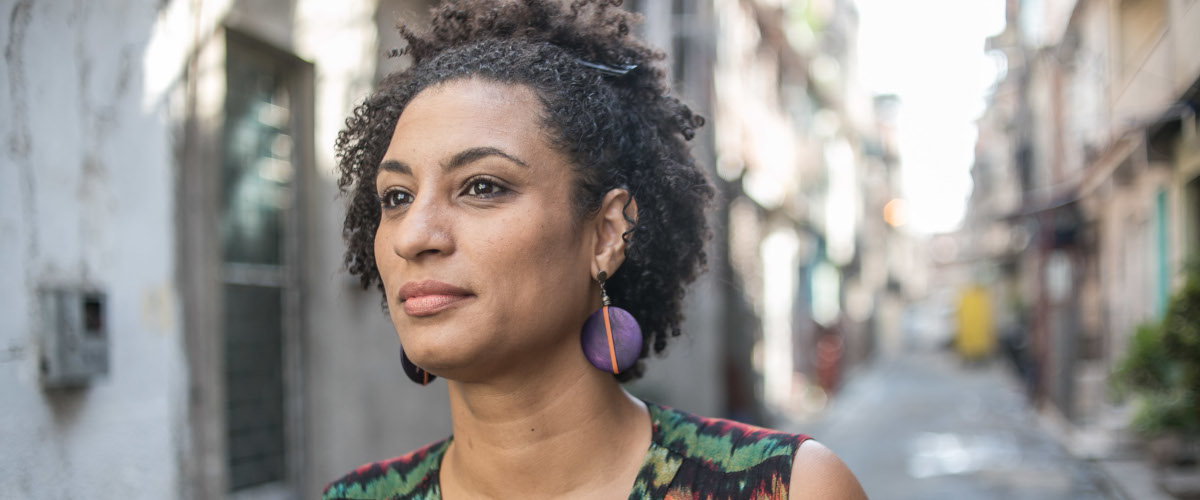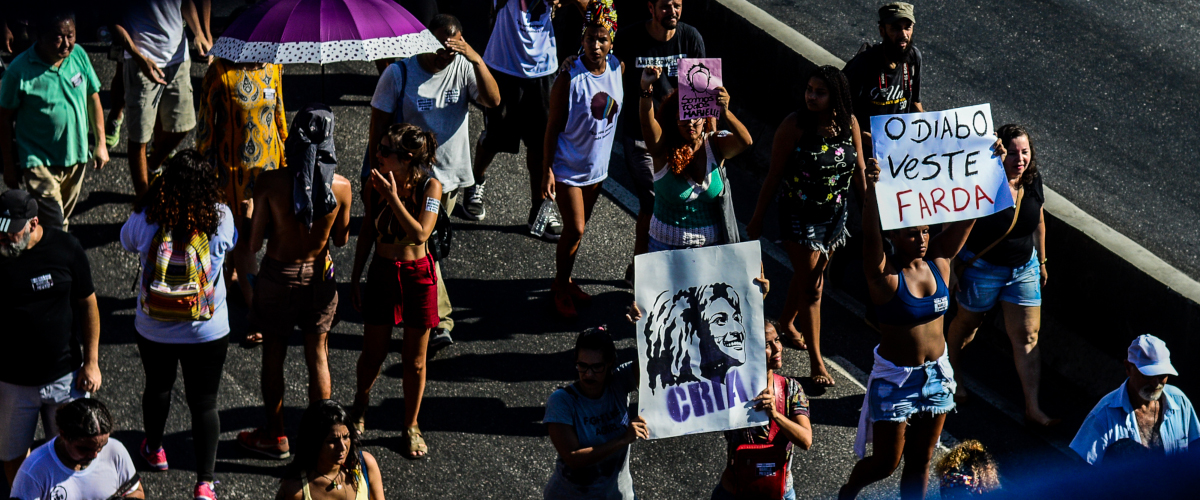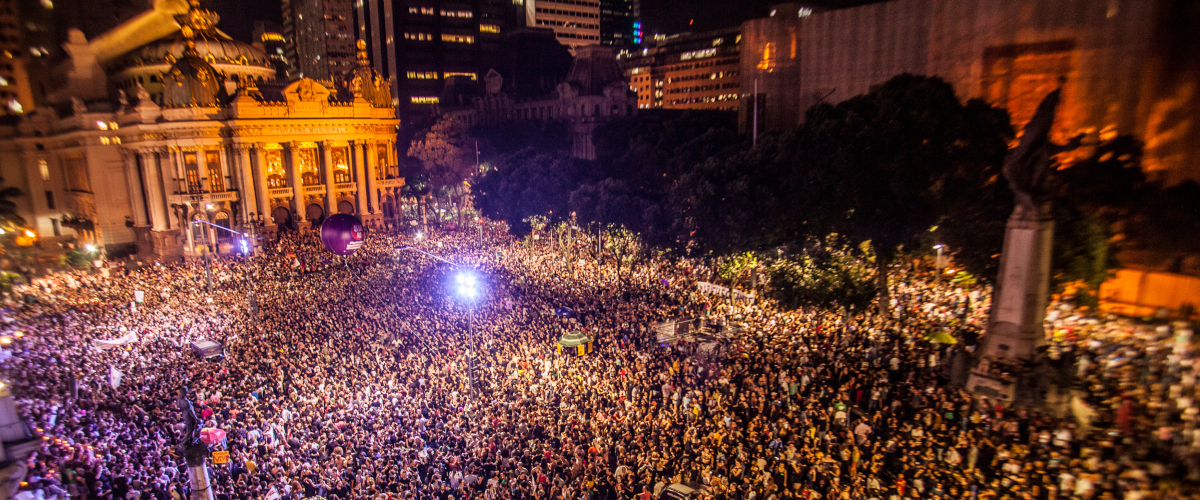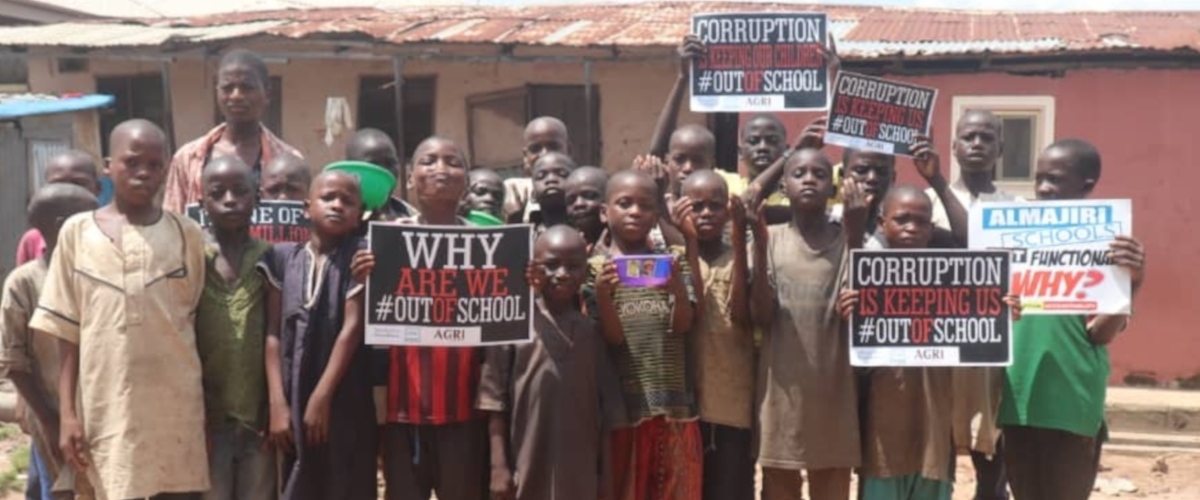
Marielle Franco in Favela Maré (Photo Credit: Midia Ninja)
On March 14, 2018, shortly before 7:00 pm, Brazilian councilwoman Marielle Franco, accompanied by her driver, Anderson Gomes, and an advisor (whose identity has been protected by the police), parked a car on a busy street in the famous neighbourhood of Lapa, Rio de Janeiro. For almost two hours, the human rights activist participated in a debate about the representation of black women in society. Just after 9:00 pm, the three left the event. They were followed by a black car with armed men inside for several kilometres until they reached Joaquim Palhares street, not far from city hall. The men opened fire – a total of 13 shots were fired from a 9mm calibre pistol. Nine bullets missed the vehicle, four shots hit Franco’s head, and three shots hit Gomes in the back region. They both died on the spot. The advisor, who didn’t suffer any serious physical injuries, pulled up the car brake, opened the back door and threw herself onto the tar, where she remained until the police and ambulance arrived.
Within less than 2 hours Brazilian digital media was flooded with speculation about the crime.
Franco, who was just 38-years-old, was a black sociologist who was married to another woman. Born in the Maré Complex – a set of favelas and small neighbourhoods in the North Zone of the city – she was among Rio’s five most-voted for councillors in 2016. Her life was dedicated to humanitarian struggles regarding social justice, racial respect and gender equality. Four days before her assassination, Franco publicly accused the military police of extorting, intimidating, torturing and killing innocent people in the poorest communities of Rio de Janeiro.
Her case was quickly associated with the brutal murder of Brazilian Justice Patrícia Acioli in 2011. Acioli was killed by a group of 11 military police officers dissatisfied with the imprisonment of public agents who were convicted by a court of law for murders and extortion in the city of São Gonçalo. On the same day of Franco’s and Gome’s killing, the Brazilian civil police began an investigation into corrupt military police officers who were reportedly involved in the crime. Investigators soon discovered that 13 9mm ammunition capsules found at the crime scene belonged to lot UZZ-18 – the same ammunition sold to the Federal Police in 2006 by the Brazilian Cartridge Company. Nine years later, ammunition from that same lot was used in a massacre in Osasco, São Paulo, that left 19 people dead. Three military police were arrested.
Speaking at a news conference in October this year, Brazilian Public Security Minister Raul Jungmann said that the investigation was close to being completed and confirmed that a councilman and a military police officer were among the suspects.
Marcello Siciliano was the councilman suspected of being involved. Siciliano was elected in 2016 with 13,553 votes; almost all of them from neighborhoods of the West Zone Rio dominated by militias (groups formed by agents of the State, such as police and firemen, who control services such as transportation, gas distribution and internet installation in poor urban areas, and who work in partnership with politicians and community leaders).
It is estimated that some 160 communities and two million people are subject to the power of militias throughout the state of Rio de Janeiro. These militias have already helped elect dozens of deputies in recent years. Several of these politicians were arrested after the establishment of the Parliamentary Commission of Inquiry of the Militias in 2008. The commission’s investigation was commanded by state congressman Marcelo Freixo, mentor and personal friend of Marielle Franco. Freixo inspired one of the characters in the movie Tropa de Elite II (2010), directed by José Padilha. The production, which had one of the three biggest audiences in the history of Brazilian cinema, portrays a complex scheme of corrupt politicians and cops who benefited from violence in the favelas of Rio de Janeiro.
Eight years after the film’s success, Franco’s case has put the spotlight back on militias, albeit in a more serious and grounded way. For many experts, police corruption schemes are the main culprits behind Brazil’s public security crisis. With low wages and poor working conditions, many Brazilian police see crime as a money-making opportunity. Some of them develop schemes with drug traffickers and burglars (who require percentages of profits to turn a blind eye), while others integrate their own militia, creating a parallel state within the favelas and demanding money to provide protection services and support to poor people living in poverty.

Public Mass for Marielle in Rio de Janeiro ”The Devil Wears a Uniform” (Photo Credit: Midia Ninja)
In an interview with Nexo newspaper, specialists Thais Duarte (author of the book The Evolution of Militias in Rio de Janeiro, released in 2012 by the Laboratory of Violence Studies of the Federal University of Rio de Janeiro) and José Cláudio Souza Alves (sociologist and author of the book A History of Violence, published in 2013), said police corruption forms a power structure that goes beyond the limits of favelas and reaches other nuclei of society and state as an aggressive cancer.
“Nowadays militias have clandestine dumps, have a strong structure, have fuel robbery mafias from Petrobras pipelines, have seats in municipal public secretariats and parliamentary force, with councilmen and deputies. This organization exists only thanks to the direct presence of security agents. They practice bribery, provide weapons, and set up schemes within the state structure”.
Duarte adds: “A difference in the actions of militia in relation to other types of criminals is their ability to infiltrate the state. Not surprisingly, the militias are mainly made up of public security agents, opening the door to corruption, ensuring greater knowledge of the functioning of the State, and making it difficult to dismantle their groups”.
To disassemble this scheme seems an impossible task, but increased pressure from the public is the first step. Marielle Franco’s death has inspired protests in more than 20 Brazilian states and in at least three other countries. The United Nations and Amnesty International have participated in these demonstrations, and have demanded action. Johns Hopkins University in the United States has launched a human rights scholarship to honour Franco. In Brazil, people are still wearing t-shirts and holding posters with phrases like “Who killed Marielle?”, “Marielle is present”, “the devil wears a uniform”, “they will not shut us up”, “Marielle did not die for nothing” and “Marielle is a seed”. The intention is to ensure that the murder investigation will be not interrupted, even though, during the Brazilian presidential elections in October 2018, the case was used as a sensationalist political strategy, and even spurned a number of fake news reports. Members of conservative parties even made claims on their social networks that Franco was the wife of one of the country’s most dangerous drug traffickers. The role of the media in this process of searching for the truth was fundamental. It is possible to say that the Brazilian media created a forceful and effective partnership with the population, dispelling rumours and ensuring coverage of public mobilizations against Franco’s death.

Marielle’s funeral in Rio de Janeiro (Photo Credit: Midia Ninja)
On October 23, during a training session for journalists at the 18th International Anti-Corruption Conference in Copenhagen, Elena Panfilova, founder of Transparency International in Russia, spoke about the power of the relationship between the media and society. “The media have a key role in fighting corruption. This role is even more powerful when the media builds an alliance with society. That is, it not only talks about theft, crimes, illicit schemes but also investigates and shows how these behaviours directly interfere in the lives of ordinary people. The media are most heard when they can personalize the stories they tell. People do not pay attention to numbers, but pay attention to names, to cases, to narratives”.
The “Who Killed Marielle?” campaign has become a historic social movement. Four women who worked for Franco’s team were elected councillors in October of this year. They say that their mission is to continue her work, to multiply their voice, and to call on the population to take to the streets and fight for transparency in the actions of the Brazilian State and its public security agents. There is no other way, after all, to guarantee democracy and the absolute defence of human rights.

